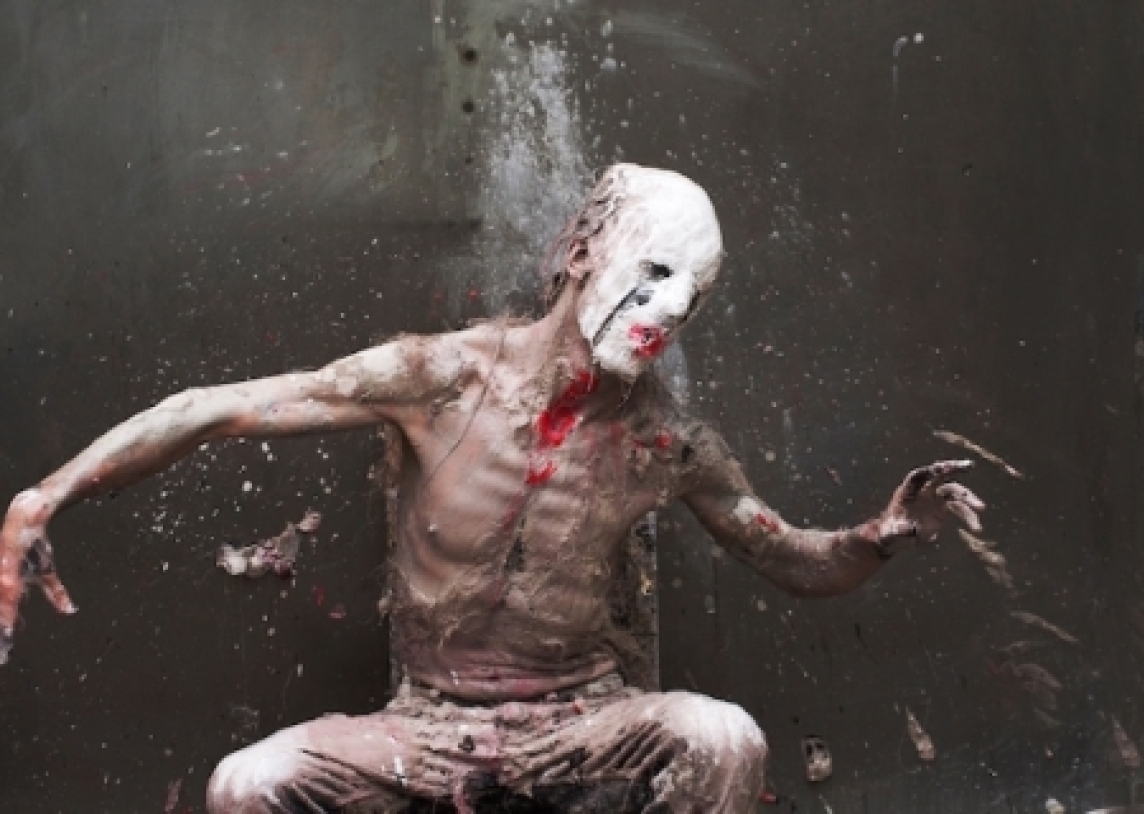News
Transfiguration
by Alistair Maxwell
Olivier de Sagazan, the French biologist, sculptor and performer has been sitting in a dark room and slapping vast amounts of clay onto his face, on and off, for twenty-four years. His solo show Transfiguration has been performed in twenty-five different countries and has become a worthy staple of the performance art scene.
An unnamed character circles the space. There are three heavy metal boards hanging centre-stage. The figure sits in front of them as if in a nest, surrounded by little bowls of black paint, red paint, straw and in front of him, a great heap of wet clay. Over the next fifty minutes he will splatter himself with clay and draw features on his new face to fantastic effect. Some faces are chilling. Some are comically smooshed. And what doesn’t land on his face, sprays and splatters on the boards behind him creating fantastic Goya-esque paintings that the artist never sees.
The piece, which is filmed, and no doubt studied by de Sagazan is not just engrossingly absurd or absurdly engrossing. It is dramaturgically flawless. Each creature is a high or a low, a comic foil, or a monstrous sight, they ebb and flow into each other like lines of dialogue carrying the audience through the emotional wringer and into this morbid sense of pity and pathos by the end. The creatures he builds onto himself and then briefly inhabits have their own lives, their own painful stories and then expire, lumps of them fall off or often the creature beneath wipes them away. He is able to sculpt himself into a fleshy Daft Punk, a xenomorph, an eldritch Dugtrio, witches, hagravens, mice and at least three different iterations of The Joker. Such is the simple power of clay, straw, a little black paint for eyes and a little red paint for a mouth. These basic tools have a seemingly infinite variety of uses and are a wonderful boon to the idea that, in theory, anyone can make art with anything. This wonder does have a disturbing underbelly however as this means this poor depraved creature could be anyone, or make themselves anything.
De Sagazan isn’t just a sculptor using his own face as a canvas, he is fully immersed in this character, this creature, this perhaps fallen angel, this possible cursed being begging for a new identity so that they may be raptured or redeemed. There are moments that scream “performance art”, hints of nudity and screeds of LOUD YELLING but even after these disturbing jolts it is impossible not to be immediately absorbed back into the action. Who is this creature? What is trying to become?
The piece continues and the guises become more and more disturbing but at no point does anyone turn away. There are twin fascinations, perfectly entwined: What is going on dramatically? How does this performer do it? Managing to breathe through clay for what could be five or ten minutes at a time is a difficult, fascinating feat. But this just adds to the feeling that this is not a show but an experience, not a set but a place between Heaven and Hell. In the Bible the transfiguration is the moment Jesus becomes radiant in glory, no longer a man but truly a holy being. The wording is specific. He does not “change”, or “become”. He undergoes something more, a transfiguration, a metamorphosis. De Sagazan or this unnamed creature is desperate to become as different to itself as Jesus was to a mortal man. It’s an engaging, off-putting show that truly makes you believe that they might just pull it off.
This publication is written in the context of the project "European Contemporary Puppetry Critical Platform"

